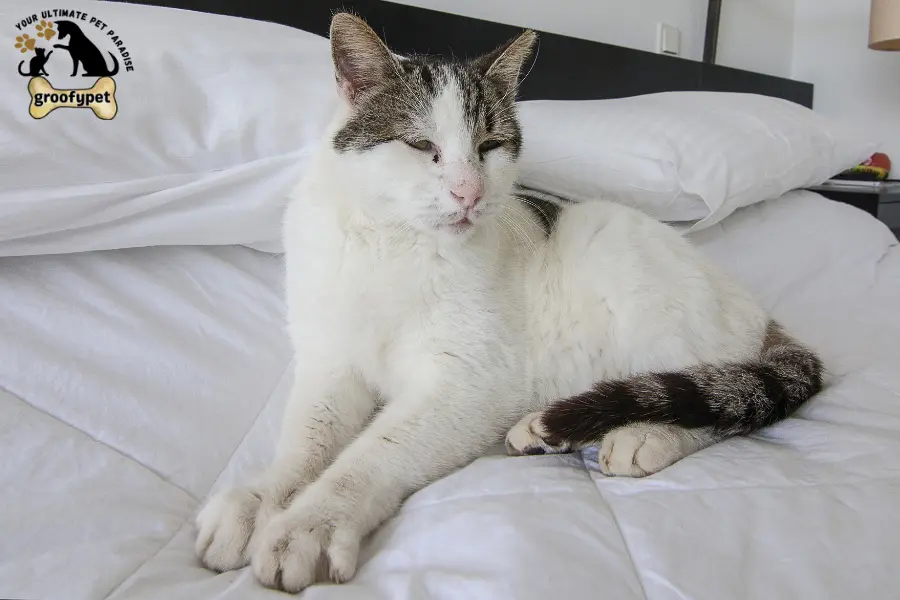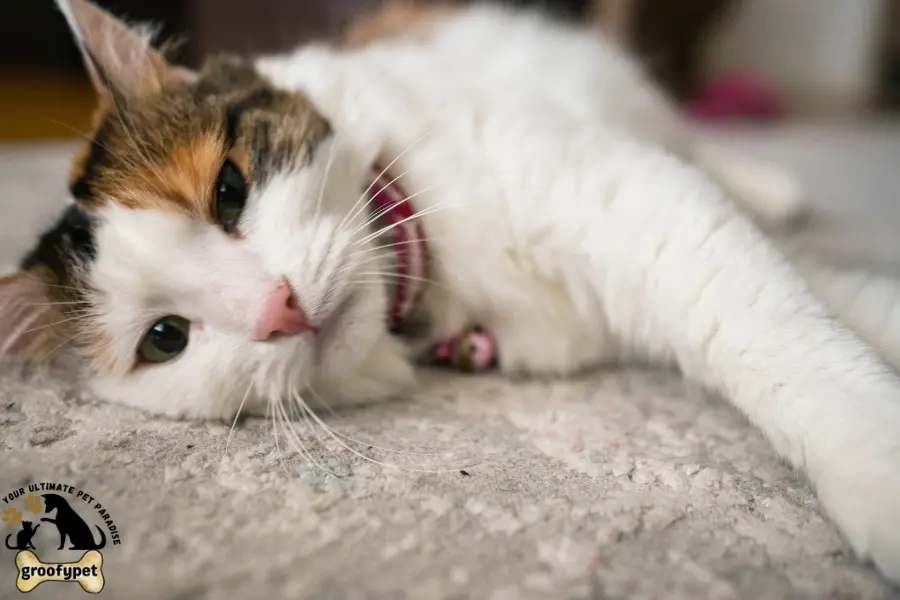
Feline hyperesthesia life expectancy is generally not reduced when the condition is properly treated and monitored. Most cats with Feline Hyperesthesia Syndrome respond well to a combination of environmental modifications, stress reduction techniques, and medication like anti-anxiety drugs or anticonvulsants. Cats with Feline Hyperesthesia Syndrome can lead comfortable, happy lives despite their condition.
Feline hyperesthesia syndrome, also called rolling skin syndrome or twitchy cat disease, is a condition that can affect cats, causing them to become extra sensitive, especially on their back. Here’s what you should know if you think your cat might have it.
Table of Contents
ToggleHyperesthesia syndrome in cats
Before diagnosing feline hyperesthesia syndrome, it’s important to rule out other conditions that match its symptoms. Cats with this syndrome usually experience short-lived episodes that last around 20 to 30 seconds. Common signs include
- Rippling or twitching skin along the lower back.
- You might also notice drooling.
- Excessive vocalization, unexpected urination,
- Behaviors like tail-chasing and intense biting or licking of the lower back, sides, hind paws, rear, or tail.
- Many cats show discomfort or pain when touched.
Your cat could react aggressively, and you can’t control it. When you spot your cat’s back twitching or notice any of the other warning signs mentioned earlier, the best thing you can do is stay calm and avoid handling them.
Hyperesthesia in cats
The exact cause of feline hyperesthesia syndrome remains unclear, as veterinary experts and researchers have yet to pinpoint a single reason behind it. Interestingly, since affected cats often respond to different treatments, it’s believed that multiple factors might contribute to this condition.

In some cases, feline hyperesthesia life expectancy appears alongside another health issue, complicating the diagnosis. Generally, the potential causes of feline hyperesthesia are grouped into three main categories: dermatological (related to skin conditions), neurological (involving the nervous system), and psychological (linked to behavioral or mental health concerns).
- Dermatological causes of FHS can include allergies, especially food hypersensitivity, and various immune-system-related diseases.
- Under Neurological Causes of FHS, conditions like seizures, neuropathic (nerve) pain, and
- IVDD (intervertebral disc disease/extrusions) is often noted.
- • On the psychological side, displacement behavior, compulsive behavior, and attention-seeking behavior are key factors.
- While feline hyperesthesia syndrome can develop in any breed,
- It appears more frequently in Abyssinian, Burmese, Persian, and Siamese cats and is typically seen more often in younger cats.
Feline Hyperesthesia Life Expectancy Overview
If your cat is showing mild to moderate signs of feline hyperesthesia syndrome (FHS), it’s best to call your vet within 24 hours to discuss what’s happening. But if your cat has a severe episode that lasts more than two or three minutes, especially if they’re hurting themselves, don’t wait—get them to an emergency vet right away.
The vet will usually start with a skin check to look for things like flea allergies, skin infections, food or environmental allergies, and other skin issues such as acral lick granulomas, even if your cat never goes outside. They’ll likely run some blood tests too, mainly to rule out hyperthyroidism, which can make cats overgroom or act extra jumpy. Your vet may also want to check for pain or neurological problems, like spinal arthritis, to make sure nothing else is going on.
Feline hyperesthesia symptoms

It’s hard for your cat to tell you what’s wrong, so pay attention to certain signs.Feline hyperesthesia symptoms you might notice are her skin twitching , strange meowing or drooling, and possibly chasing her tail. Cats may also bite or lick their flanks, lower back, or tail, and they might even seem to be in pain when you pet them. If you notice these, it’s a good idea to check with your vet.
Feline hyperesthesia treatment
Hyperesthesia, along with other forms of neuropathic pain, can be challenging to manage.Feline hyperesthesia treatment may not always be completely curable, the symptoms are to be controlled. Treatment options may include lifestyle changes, minor surgical procedures, and medications such as pain relievers, antidepressants, topical treatments, or opioids, depending on your specific condition.- A behavioral assessment might be part of the process as well, to see if something like obsessive-compulsive disorder (OCD) could be a factor.
- Sometimes vets try out medications to see how your cat responds—this can be really helpful since cats are great at hiding when they’re uncomfortable.
- Watching how they react to meds for pain or itchiness can give the vet more insight.
- It’s good to know that FHS often shows up alongside other issues.
- Even if your cat is diagnosed with something else, it doesn’t mean they don’t also have FHS.
- When your vet has ruled out other health issues and confirmed a diagnosis of feline hyperesthesia, they might recommend a well-planned plan.
One of the first things to tackle is the environment. Since FHS behaviors are concerned with stress or changes at home, your vet may suggest simple adjustments like setting up a quiet, cozy space where your cat feels safe—especially away from kids, dogs, or loud areas. Keeping litter boxes clean and easily accessible is also important, and if you’re making any big changes at home, it’s best to do them gradually. Sometimes adding a pheromone diffuser can help calm things down too.
Medication or supplements might be part of the mix as well. Many vets turn to gabapentin to help manage nerve pain and anxiety, and in some cases, they might recommend something like amitriptyline. Skin and anxiety supplements, such as omega-3 fatty acids, could also be helpful, but check with your vet before introducing anything new.

Behavior modification is another key piece. This usually involves helping your cat slowly get used to whatever is triggering their stress or teaching them new ways to cope. A behaviorist can walk you through techniques that not only reduce the number but also help your cat feel at ease overall.
Some cats also have food sensitivities that could contribute. This condition is most common in younger cats, especially those under seven, and it often starts around one year old. Certain breeds like Burmese, Persian, Abyssinian, and Siamese are more likely to develop it.
Must read : Why are Cats So Soft?
How to calm a cat with feline hyperesthesia?
If your cat is having an episode, try wrapping her gently in a towel and holding her to comfort her. It can help calm her down. A small amount, around 1/4 teaspoon in the morning and evening, may help, though not all cats react to catnip.
Feline Hyperesthesia Life Expectancy Insights
Feline hyperesthesia syndrome usually causes short episodes that last between 20 and 30 seconds. During these bursts, you might notice symptoms such as twitching or rippling of the skin on the lower back, which can happen after being touched or without any clear trigger, as well as dilated pupils.
How long do cats live with hyperesthesia?
Hyperesthesia is a lifelong condition, though the episodes typically last only one to two minutes. With proper management, including behavioral adjustments, medications, and alternative treatments, cats can live well with the syndrome—provided they don’t excessively self-mutilate.
Can anxiety cause hyperesthesia?
When the body is pushed into a state of chronic stress or anxiety, it can become overly sensitized, leading to heightened senses and an overactive nervous system. This overstimulation often results in increased sensitivity to touch, sound, or other sensory input, making the nervous system more reactive and contributing to symptoms of hyperesthesia.
Final Thoughts
While it isn’t life-threatening, feline hyperesthesia life expectancy makes your cat uncomfortable. If you think your kitty has it, see your vet. For mild cases, you can schedule an appointment, but if her symptoms are severe, it’s best to get help right away.
Your vet will run tests to confirm the diagnosis and make sure there aren’t other issues at play, like arthritis or infections. The good news is that treatment, often with medications, can help many cats feel better. Some may also benefit from behavioral therapy or changes in their environment.
Cat Behavior Heat: An Essential Guide to Loving Your Cat!
How Much Should My Cat Eat? A Guide to Keeping Your Feline Healthy



